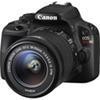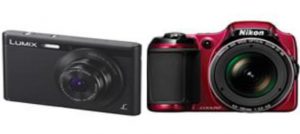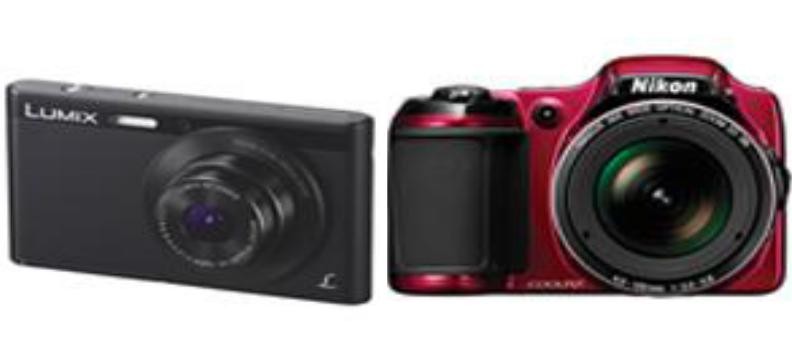By Manzanillo Sun Writer from the August 2013 Edition
Photography has evolved to the point where the cost of photos is essentially free, once you have purchased the photographic equipment. If you ever used a film camera, each photo had a cost; film and then developing and printing; and you had to wait until the whole process was complete to see the results. If the photo was out-of-focus, or the subjects had their eyes closed, or the lighting was incorrect, then the photographic moment was lost forever.
Digital photography has changed the way memories can be preserved. Digital photographic equipment allows the user to immediately review their photo in a viewfinder. If the photo is not right, a new one can be taken and the old deleted. Anyone can be a great photographer!
Digital cameras come in a variety of form factors and each one has positives and negatives.

DSLR ( digital single lens reflex ) cameras allow the photographer to use a variety of interchangeable lens. There are a number reasons to use different lenses such as; low light conditions, close-up photography, portrait photography as some examples These cameras are typically used by professional photographers and are the most expensive. In this class of camera there is a wide range of camera bodies and lenses, so they are also affordable for amateur enthusiasts. Prices for a DSLR camera range from $300.00 to many thousands of dollars. The disadvantage of a DSLR camera is the size and weight of the body and lenses. It is this reason that I do not recommend the casual user purchase this type of camera. These cameras are also more complex to operate.
Digital photography equipment has a number of components that control the quality of output. One of the most important components is the optics, the lens ( low quality lenses require more light and do not capture sharp photos ). Next is the sensor size, a larger sensor allows more data to be collected and therefore more pixels ( photo resolution is affected by pixels, more is better ). Next is the camera firmware ( the software and hardware that controls the camera ), lower priced cameras may not render colours properly due to slower processor chips. The slower processor chips may also cause a delay between pressing the shutter button and capture.

Fixed lens cameras ( point and shoot ) are lighter and as result are more likely to be carried. There are two types of cameras in this class, thin body cameras that can be fit into a purse or pocket, or a box type with a fixed lens. The box type will typically have better quality lens and a larger sensor. The box type camera generally has a greater zoom range and will produce better quality photos. Point and shoot cameras range in price from $60.00 to $1,300.00.
Cameras in the lower price range will typically have a thin body and will only take basic photos ( see paragraph above ). Cameras in this category have an electronic viewfinder, before you buy a camera, ask to see the viewfinder in daylight. If the viewfinder is not bright, it will hard to compose and view photos in sunlight conditions.
If outdoor photography is a consideration, find a camera with a viewfinder that displays well in sunlight. Next take a few sample shots, if the camera has a delay between pressing the shutter and capture of the photo, look at another camera. Many good portrait photos are missed because the camera delay was a second late. Ask the salesperson to show you the features that interest you.
If you want to take close-up photos, ask to see models that have a high optical zoom factor ( do not look at digital zoom, this only magnifies the photo and is not a true representation of zoom ). If you want extreme close-up shots ask to see models with a macro feature.
One drawback of close-up photography is that any movement while taking the photo will cause blurring, either consider a tripod or a camera with a fast lens (a faster lense will dramatically increase the cost of the camera), blurred photos can also be minimized by shooting in bright daylight conditions.
The major disadvantage of point and shoot cameras is carrying them at all times.

Modern smartphones also have built-in cameras. The advantage of these cameras is that they are always with us. Most current smartphone models have 8 megapixel sensors and even process video photography. These phone cameras are better than the lower priced point and shoot cameras in both quality and colour rendition. Tablets also have digital cameras with 5 megapixel sensors. But are not as convenient to carry as the smartphone.
Digital photography has progressed to the stage where the quality has surpassed film. Image editing software can improve imperfections of the photo, such as red eye reduction, cropping and colour correction. Digital photos can be made into prints either by taking the memory card to a photo finishing kiosk or uploading to any number of photo processors. I upload my photos to Costco then pick them up a few hours later. The other advantage of digital photos is that only the photos selected are printed thereby reducing costs. These photos can also be printed on a colour printer, but I have found the cost of ink and photo quality paper is more expensive than a commercial photo processor.
Memories are priceless, so remember to backup and store your images on other media as well as have a copy at an offsite location.
If you have a topic you would like covered, or require further information on this topic, please contact me at techguy@senortech.ca.
Download the full edition or view it online
Manzanillo Sun’s eMagazine written by local authors about living in Manzanillo and Mexico, since 2009





You must be logged in to post a comment.